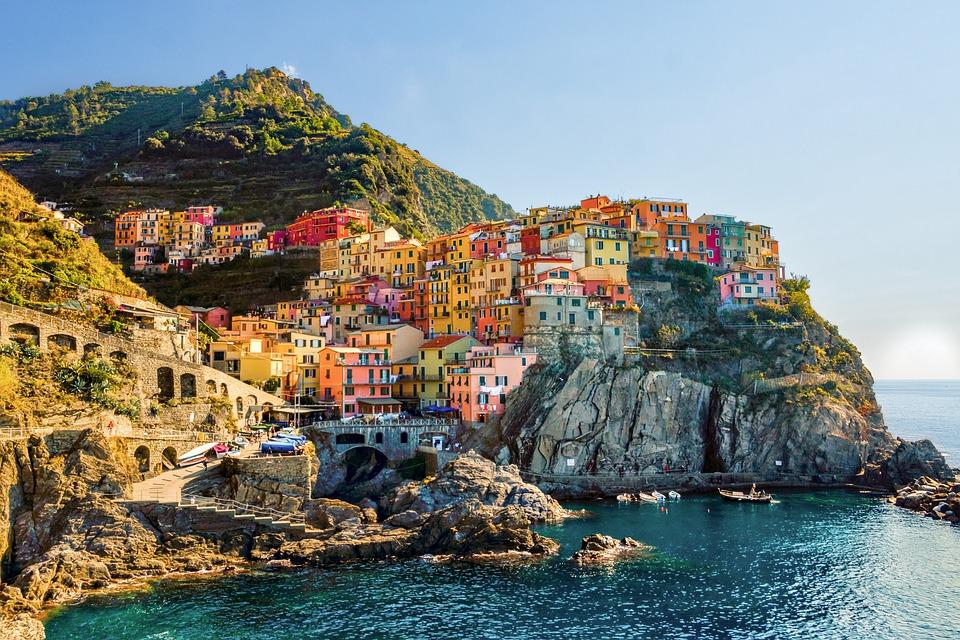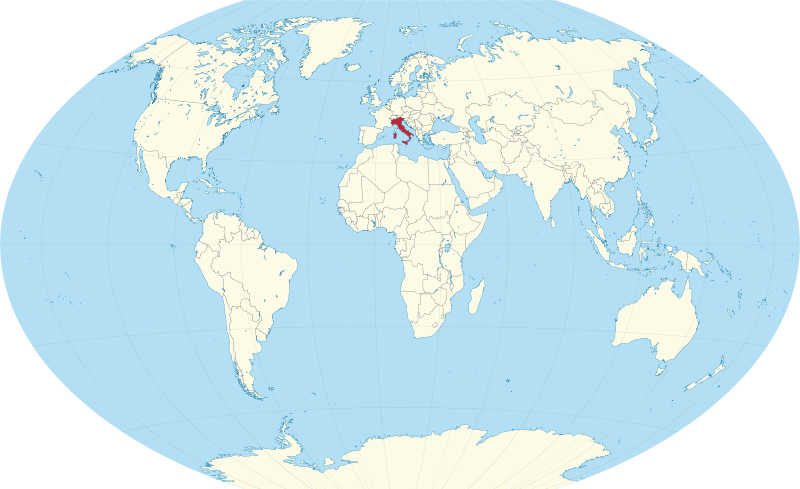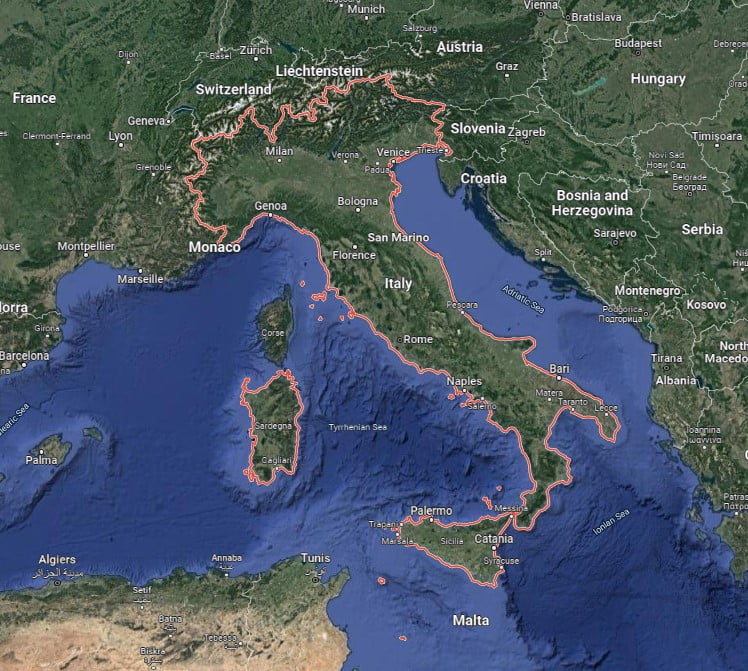As one of the most notable countries on the world map, the Italian boot stand out immediately. Besides being a beautiful and diverse country, Italy is a major global economy. Italy competes in its export markets by focusing on high-quality products, such as luxury supercars, fashion, and wine. But how big is Italy actually? We did some research…
Italy: prominent European peninsula
Italy is populated by approximately 60 million people, making it the third-most populous country in the European Union. The capital city is Rome, which is also the largest Italian city. Italy has great cultural wealth, and is a major hub for art and fashion.
The vibrant history, but also the overall pleasant climate, contributes towards making it an attractive tourist spot for many destinations, and it is the fifth-most visited country in the world.

Interesting facts on Italy
The official language is Italian, which has developed from Latin. In fact, it is the closest language to Latin among modern national languages. The country has played a central role in European history. The Roman Empire extended over a large part of Western Europe, advancing culture and technology.
Later, the seeds of capitalism and banking were laid in Italy, as well as the start of the Renaissance period. However, the significance of the area waned slightly in comparison to others as the Age of Discovery diverted trade from the Mediterranean.
Nevertheless, Italy is a developed country and their GDP is the eight-largest in the world.
The majority of Italians are Roman Catholics, with a representation of around 75%. The central government of the global Catholic Church is located in Rome, ruled by the Pope.
Vatican City, also in Rome, is the seat of this papal jurisdiction and it is the smallest sovereign state in the world. Minority religions include Orthodox Christians, Hinduism, Pentecostals, Evangelicals, Jehovah’s Witnesses, etc.
Italian workers are required to contribute 0.8% of income tax to a religious community, however they can choose to direct this to the state welfare system instead.

Major Cities in Italy
Italy is known for its historic, cultural and above all beautiful cities. The five largest Italian cities by population are:
- Rome: 2,780,000
- Milan: 1,400,000
- Naples: 940,000
- Turin: 850,000
- Palermo: 640,000
Although Rome is the largest city in terms of the actual administrative region, the urban area of Milan populates over 10 million people, making it the largest in Italy.
Map of Italy
Italy is located on a peninsula extending into the Mediterranean Sea. The Italian Peninsula is also known as Io Stivale, or ‘the Boot’, because of its form. The form of a boot is contributed by three smaller peninsulas, namely Salento (the ‘heel’), Calabria (the ‘toe’) and Gargano (the ‘spur’).
Italy has borders with Switzerland, France, Slovenia, and Austria, as well as the enclaved states (completely surrounded by Italy) San Marino and Vatican City.
In addition to the Italian Peninsula, the large islands Sicily and Sardinia are part of Italy, as well as many smaller islands and archipelagos.

Italy consists of several mounts, with the Apennine Mountains running through the country and the Alps in the North. Mont Blanc is the highest mountain in Western Europe (4807 m above sea level), and is located on the border of Italy and France in the Alps.
The Dolomites are an eastern extension of the Alps, and run across northeast Italy. There are three active volcanoes in Italy, with Mount Etna in Sicily being the biggest active volcano in Europe. Besides this, many of the smaller islands are of volcanic origin, but no longer active.
The mountainous character of Italy also results in several rivers. The longest river is the river Po (652 km long), which flows all the way from the Alps in the north to the Adriatic Sea. The valley that the river flows through, the Po Valley, is the largest plain in Italy.
There are twenty administrative regions in Italy: for instance, Rome is in the region called Lazio. Five of the regions are autonomous due to large cultural differences. This means that they have more power over things such as their internal legislation, administration and finance than the others.

How big is Italy?
Italy is the 73rd largest country in the world by land area, and 23rd by population. It is one of the most important economies in the world, and ranks 8th largest in terms of gross domestic product (nominal GDP).
Geographic size of Italy
How big is Italy geographically? Italy covers an area of 301,230 km2 (or 116,306 sq mi). The majority of this area is land, only 7,210 km2 (or 2,784 sq mi) is water, with Garda, Maggiore and Como being the largest lakes of the beautiful country. Italy covers 0.2% of the total world mass. Out of its land area, around 35% is mountainous terrain, with the Mont Blanc as its highest point.
In comparison to other countries, it is only slightly smaller than Norway, Oman or Poland, but somewhat larger than the New Zealand or United Kingdom.
| US customary | Metric system | |
|---|---|---|
| Total area | 116,306 sq mi | 301,230 km2 |
| Total land area | 113,522 sq mi | 294,020 km2 |
| Total water area | 2,784 sq mi | 7,210 km2 |
| Longest North-South extent | 718 mi | 1,155 km |
| Longest West-East extent | 579 mi | 932 km |
Population size of Italy
How big is Italy in population? Although Italy is smaller in land area than similar sized countries Finland or Norway, it’s populated by more people. The population of Italy is 60,461,826 – making it the 23rd most populated country in the world.
This is roughly the same amount of people living in South Africa or Tanzania. The population density is 206 per sq km (or 533 per sq mi), which ranks Italy 72nd in the world.
| US customary | Metric system | |
|---|---|---|
| Population | 60,461,826 | – |
| Population density | 533 per sq mi | 206 per km2 |
Economic size of Italy
How big is Italy economically? With a nominal GDP of $2.12 trillion, the Italian economy is the 3rd largest among countries in the Eurozone, and 8th largest in the world. Regarding nominal GDP per capita, the country ranks 33rd worldwide with a nominal GDP of $31,770 per citizen.
There’s a high quality of life, although there is a sharp division between the North and South of Italy.
The automotive industry is especially important, and it contributes nearly 10 percent of the Italian GDP. There is a strong cooperative sector, with 4.5 percent of the population employed in a cooperative. This is the highest of all EU countries.
| Stats | |
|---|---|
| Nominal GDP | $ 2,120.2 billion |
| Nominal GDP per capita | $ 35,067 |
| Government dept | 154.8% of GDP |
Also read: